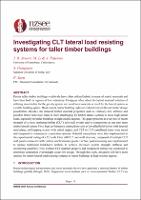| dc.description.abstract | Recent taller timber buildings worldwide have often utilized hybrid systems of mixed materials and have been built in regions of low seismicity. Designers often adopt the hybrid material solution of utilizing mass timber for the gravity system and reinforced concrete or steel for the lateral system as a viable building option. Most current timber building codes are behind state-of-the-art timber design possibilities. Besides, the inherent timber material properties such as relatively low stiffness and possible brittle behaviour make it more challenging for timber lateral systems to resist high lateral loads, especially for taller buildings in high seismic regions. This paper presents an overview of recent research of a cross-laminated timber (CLT) core-wall system and its connections as one new mass timber lateral system. First, high performance connections such as dowelled hold-downs with internal steel plates, self-tapping screws with mixed angles, and CLT to CLT castellated joints were tested and compared to commercial connection systems. Selected connections were then implemented in the experimental testing of a 2/3 scale 8.6m tall CLT core-wall structure, composed of multiple CLT wall panels connected with vertical and horizontal joints. Further, post-tensioning was implemented to replace traditional hold-down anchors to achieve increased system strength, stiffness and recentering capability. New Zealand CLT material property and component testing was conducted to determine connection overstrength values for design. Through this work, designers will have more options for timber lateral load resisting systems in timber buildings in high seismic regions. | |

